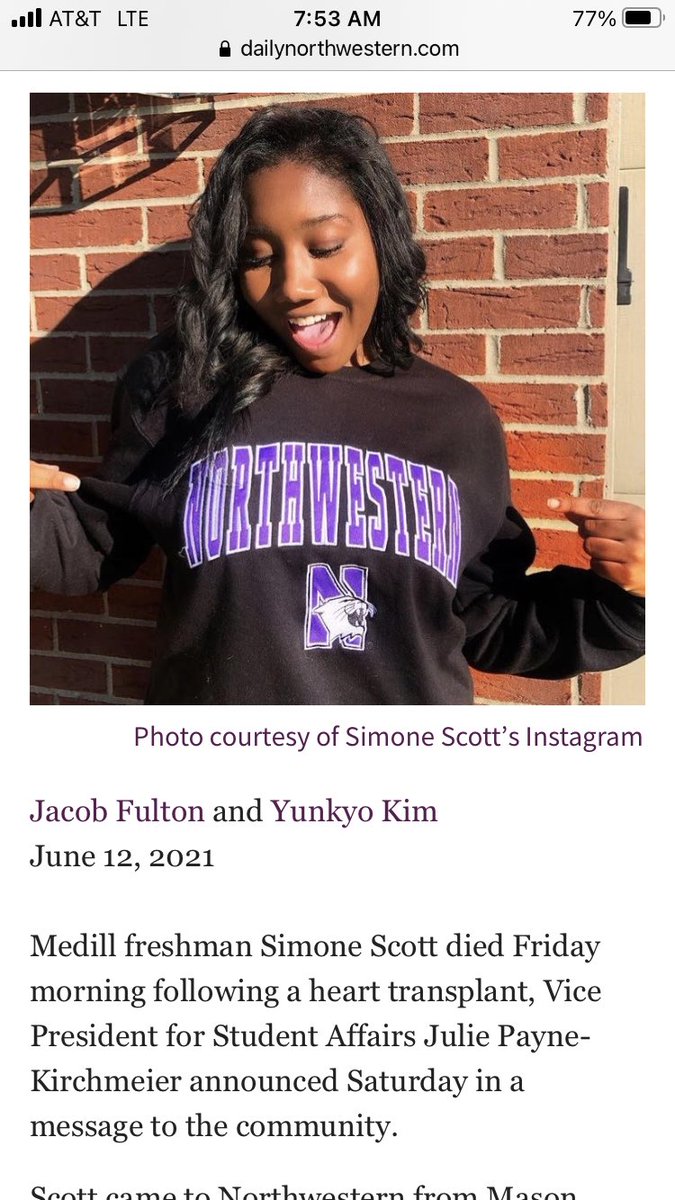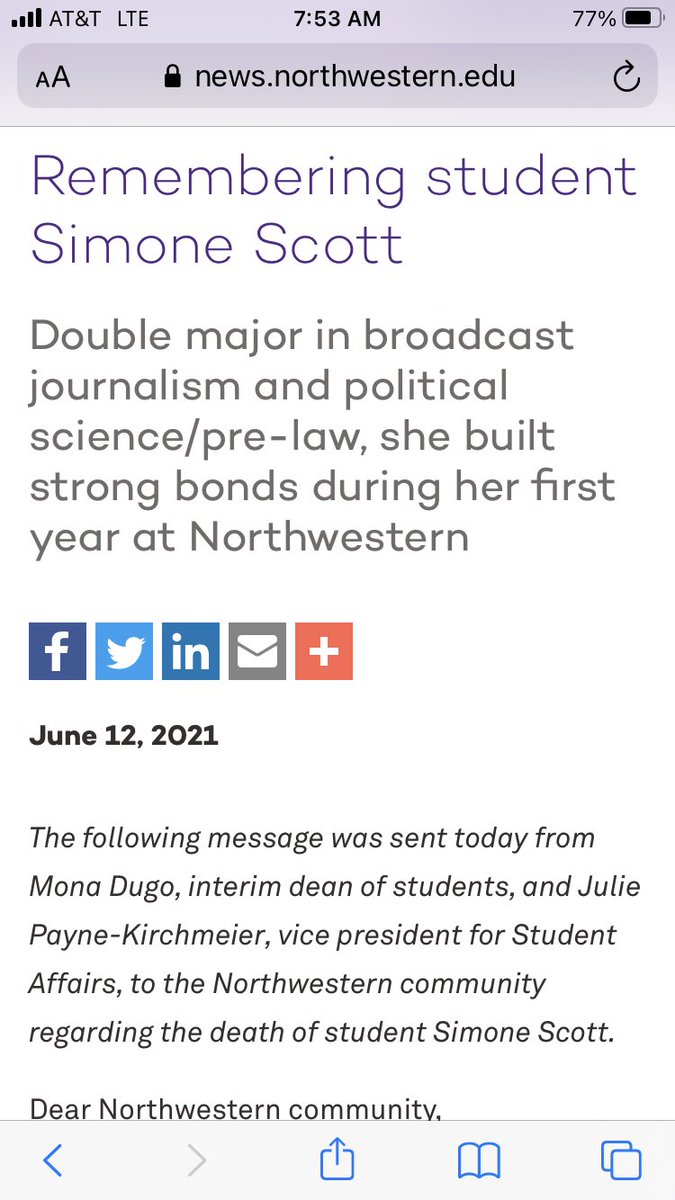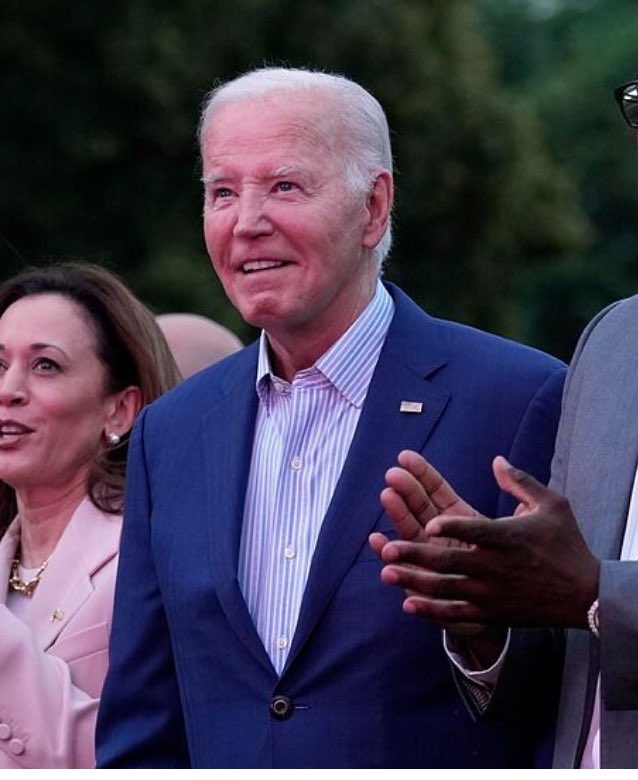THREAD
19-year-old Simone Scott was excited to get her second dose of @moderna_tx’s #Covid vaccine on May 1.
Now her mother Valerie Kraimer is arranging her funeral.

19-year-old Simone Scott was excited to get her second dose of @moderna_tx’s #Covid vaccine on May 1.
Now her mother Valerie Kraimer is arranging her funeral.


Simone, a first-year Northwestern University student, suffered a case of apparent myocarditis-induced heart failure on Sunday, May 16.
Despite extraordinary measures to save her, including a heart transplant, she died Friday morning at Northwestern Memorial Hospital in Chicago.
Despite extraordinary measures to save her, including a heart transplant, she died Friday morning at Northwestern Memorial Hospital in Chicago.
Now her parents are struggling to understand what happened to Simone – and why they had no idea the Covid vaccines might cause myocarditis.
“I lost my only daughter,” Kraimer said Sunday night. “I never thought I’d have to give up my daughter for the greater good of society.”
“I lost my only daughter,” Kraimer said Sunday night. “I never thought I’d have to give up my daughter for the greater good of society.”
Doctors appear to have repeatedly missed signals as Simone’s condition worsened in the two weeks following her second shot – before she abruptly crashed.
In mid-May, Israel was reporting high rates of cases of mRNA vaccine-related myocarditis in young people.
In mid-May, Israel was reporting high rates of cases of mRNA vaccine-related myocarditis in young people.
But in the United States, vaccinations had just been opened for 12-15 year-olds - and @CDCgov played down the myocarditis risk in young people.
In a statement May 17, the day after Simone died, the CDC reported that it had found “relatively few reports of myocarditis to date...”
In a statement May 17, the day after Simone died, the CDC reported that it had found “relatively few reports of myocarditis to date...”
Simone’s physicians still have not confirmed that her vaccine caused her heart failure.
But despite nearly a month of intense investigation, including an pathological examination of her heart after its removal in the transplant, they have offered no other explanation.
But despite nearly a month of intense investigation, including an pathological examination of her heart after its removal in the transplant, they have offered no other explanation.
“My fear is that we’ll never know what happened to Simone,” her father, Kevin Scott, said Sunday night. “[The vaccine] is a coincidence that is too big to ignore.”
“I do suspect it was the vaccine,” Kraimer said. “If it wasn’t direct, it played a role.”
“I do suspect it was the vaccine,” Kraimer said. “If it wasn’t direct, it played a role.”
Simone had been a healthy young woman, her only notable illnesses a bout of pneumonia when she was an infant and a second in high school.
She told her mother in sixth grade she wanted to go to Northwestern. Six years later she applied early to the university and was accepted.
She told her mother in sixth grade she wanted to go to Northwestern. Six years later she applied early to the university and was accepted.
“She was very, very disciplined," Kraimer said.
That discipline extended to her attitude toward Covid. She always wore masks and followed Northwestern’s sometimes onerous rules about testing when the school allowed its first-year students on campus in January.
That discipline extended to her attitude toward Covid. She always wore masks and followed Northwestern’s sometimes onerous rules about testing when the school allowed its first-year students on campus in January.
Despite its Covid restrictions, the school was everything she hoped, her mother said.
She produced stories for the school’s in-house television network and quickly made friends.
“She was a Wildcat [the Northwestern mascot] through and through,” Kraimer said. “She bled purple.”
She produced stories for the school’s in-house television network and quickly made friends.
“She was a Wildcat [the Northwestern mascot] through and through,” Kraimer said. “She bled purple.”
And when Illinois opened vaccinations to younger people, she quickly made an appointment.
“She took it upon herself to get vaccinated,” Kevin Scott said.
But she suffered serious short-term side effects after her first dose April 3 and never fully recovered, her parents said.
“She took it upon herself to get vaccinated,” Kevin Scott said.
But she suffered serious short-term side effects after her first dose April 3 and never fully recovered, her parents said.
Throughout April she had a cough and and felt fatigued. Simone checked in with her mother, who lived near Cincinnati, frequently. Kraimer asked her to go to a doctor.
But neither Simone nor her mother considered whether the vaccine might be behind her symptoms, Kraimer said.
But neither Simone nor her mother considered whether the vaccine might be behind her symptoms, Kraimer said.
“We thought it was either allegories or a sinus infection.”
So on May 1, as scheduled, Simone received her second Moderna vaccination. This time she had fewer immediate side effects.
So on May 1, as scheduled, Simone received her second Moderna vaccination. This time she had fewer immediate side effects.
But when she flew back to Ohio to surprise her mother for Mother’s Day, Sunday May 9, Kraimer noticed she seemed tired. And Simone told her mother she’d had repeated nosebleeds.
Kraimer told her she needed to make an appointment with a doctor.
Kraimer told her she needed to make an appointment with a doctor.
Back in Illinois on Wednesday, May 12, she did.
But the visit was virtual and Simone forgot to mention that she’d noticed swelling the day before in her lymph nodes.
The physician told her she probably had allergies.
But the visit was virtual and Simone forgot to mention that she’d noticed swelling the day before in her lymph nodes.
The physician told her she probably had allergies.
The next day, she had a low fever and went to the student health clinic. Tests for Sars-Cov-2, flu, and other viruses were negative.
A doctor noted Simone’s heartbeat was irregular but discharged her, telling her to go to the emergency room if the problem worsened, Kraimer said.
A doctor noted Simone’s heartbeat was irregular but discharged her, telling her to go to the emergency room if the problem worsened, Kraimer said.
The following day she’d developed a sore throat. She went back to the clinic. By now Kraimer was worried enough to insist her daugher FaceTime the visit.
Simone was told she might have a viral infection, given an anti-viral prescription, and again sent back to her dorm room.
Simone was told she might have a viral infection, given an anti-viral prescription, and again sent back to her dorm room.
By Friday night she was suffering severe fatigue.
Still, her parents assumed she was simply rundown and sick, especially since doctors had now seen her three times in three days.
“People do get sick, and you get some rest, and you sleep, and you get through it,” Kraimer said.
Still, her parents assumed she was simply rundown and sick, especially since doctors had now seen her three times in three days.
“People do get sick, and you get some rest, and you sleep, and you get through it,” Kraimer said.
But everything changed Sunday, May 16. Simone texted her father she was too dizzy to get out of bed or eat.
Her mother packed a bag and began the drive from Ohio to Illinois. Her dad called campus police and asked them to check on her. After initially refusing, the police did.
Her mother packed a bag and began the drive from Ohio to Illinois. Her dad called campus police and asked them to check on her. After initially refusing, the police did.
They found Simone unable to walk and called an ambulance to take her to nearby North Shore Hospital.
Kraimer arrived there that night. When she explained who she was there to see, she was escorted into a waiting room. “That’s when I knew things were not right,” she said.
Kraimer arrived there that night. When she explained who she was there to see, she was escorted into a waiting room. “That’s when I knew things were not right,” she said.
A doctor appeared, telling her that her daughter had gone into heart failure as she was being transported to the hospital and needed immediate surgery.
“They said her heart was not functioning and they needed to insert a balloon pump to get it working.”
“They said her heart was not functioning and they needed to insert a balloon pump to get it working.”
Doctors almost immediately diagnosed Simone with myocarditis - heart inflammation, often caused by viral infection. "They did at that point suspect that it was myocarditis," Kraimer said. "They were thinking it was a virus that had attacked her heart."
But Simone's implant failed to restore her heart function. The next day, she was placed on ECMO, a heart-lung bypass. Nearly a month of increasingly desperate medical procedures followed.
On May 20, with a transplant looming, Simone was moved to Northwestern Memorial, the university’s primary teaching hospital.
She was sedated most of the time, but doctors sometimes lightened the sedation enough for her to text her parents. “Am I going home with you?” she asked.
She was sedated most of the time, but doctors sometimes lightened the sedation enough for her to text her parents. “Am I going home with you?” she asked.
On Sunday, May 23, Simone’s physicians told her parents that her heart did not seem to be recovering on its own and a transplant was her best option.
“We didn’t have much choice,” Kraimer said.
She had the transplant that night. Ultimately, her new heart did begin to pump.
“We didn’t have much choice,” Kraimer said.
She had the transplant that night. Ultimately, her new heart did begin to pump.
But her lungs had been severely damaged, and the immunosuppressive drugs necessary for her to avoid rejecting the transplant led to severe lung infections.
After a few hopeful days, her prognosis dimmed.
After a few hopeful days, her prognosis dimmed.
Her parents never completely lost hope.
But on the morning of Friday, June 11, her doctors told them that they could no longer control her blood pressure and that they should come to say goodbye.
At 11:19 a.m., Simone Scott died. She was 19.
But on the morning of Friday, June 11, her doctors told them that they could no longer control her blood pressure and that they should come to say goodbye.
At 11:19 a.m., Simone Scott died. She was 19.
Kraimer and Simone's father repeatedly asked whether the hospital intended to report the case to VAERS, the federal system to report vaccine side effects.
Doctors did not seem particularly interested in doing so for most of the time Simone was there, Kraimer said.
Doctors did not seem particularly interested in doing so for most of the time Simone was there, Kraimer said.
“We kept asking if they did and nobody could tell us if they did,” Kraimer said. “It was just a runaround.”
Finally, the day before Simone died, a physician’s assistant promised to report the case.
Finally, the day before Simone died, a physician’s assistant promised to report the case.
With their daughter gone, Simone's parents are now hoping that her story will – at the least – raise awareness of the potential for post-Covid vaccine myocarditis.
“I never knew that there was a risk for something as serious as this,” Kraimer said. “I would have wanted to.”
“I never knew that there was a risk for something as serious as this,” Kraimer said. “I would have wanted to.”
In the meantime, they are left to mourn the loss of their only child.
On May 12, four days before Simone collapsed, Northwestern required all its students – with very limited exceptions – to be vaccinated for the fall 2021 term.
END
On May 12, four days before Simone collapsed, Northwestern required all its students – with very limited exceptions – to be vaccinated for the fall 2021 term.
END
• • •
Missing some Tweet in this thread? You can try to
force a refresh












